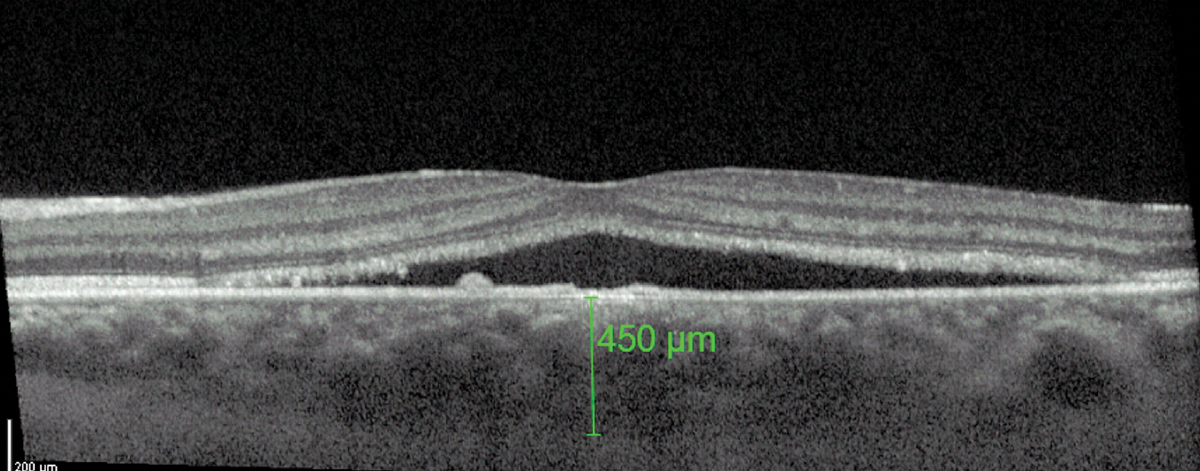 |
| The occurrence of ellipsoid zone rupture in this elderly cohort will inevitably affect the physiological and metabolic activities of photoreceptors, and may also affect RPE cells, which will eventually reduce their pumping capacity and lead to the decline of vision. Photo: Mohammad Rafieetary, OD. Click image to enlarge. |
The stereotypical patient with central serous chorioretinopathy (CSCR) is a middle-aged, Type A male with a stressful job that frequently triggers episodes of the condition. While that does ring true, central serous also affects a wider range of patients and personalities. What of elderly patients, for instance? Limited research has been conducted. Researchers in China evaluated the characteristics of retina, choroid structure and blood flow in patients with chronic CSCR older than 50 and discovered, with multimodal imaging, more serious choroidal and retinal structural damage and ischemia in this older cohort. This group also had lower gender tendency towards men, poorer vision and a higher risk of choroidal neovascularization.
Newly diagnosed treatment-naïve chronic CSCR patients were included in this study. They were divided into two groups according to age: those between 20 and 50 years old included 45 men (47 eyes) and 13 women (15 eyes), while the elderly group (age ≥ 50) comprised 18 men (20 eyes) and 14 women (17 eyes). No complications were observed in the young group, but seven patients had comorbidities of hypertension, three had comorbidities of diabetes and two had comorbidities of lower limb varicose veins in the elderly group. The researchers also recruited 40 age- and sex-matched controls (40 eyes).
The proportion of female patients in the elderly group (43.8%) was significantly higher than that in the younger group (22.4%). The degree of hyperopia in the elderly group (1.03) was higher than that in those under age 50 (0.26), with a significant difference in BCVA. The thickness of subfoveal thickness, central macular thickness and outer nuclear layer measurements in the elderly group, as well as the length of the photoreceptor outer segment in the elderly group, were thinner than those in the younger group. Choroidal capillary perfusion area, macular area and paramacular area were also lower in the elderly group in the full scan range.
The study found that blood flow densities of deep capillary plexus, intermediate capillary plexus and superficial capillary plexus in the whole scan range, macular area and paramacular area were lower in the elderly group than in the youth group, but the differences were not statistically significant. Nevertheless, the researchers believe that the decrease in the types of blood perfusion will definitely lead to the disorder of metabolism in the corresponding retinal regions.
“Chronic CSCR affects not only affected the choroidal vascular system but also the retinal capillary system, and the whole retina was in a state of hypoperfusion,” the researchers wrote in their paper. “The choroidal capillary perfusion area reduction in the elderly group is particularly significant compared with the young group, suggesting that the blood supply of the outer retina in the elderly group is seriously insufficient, which corresponds to the more serious destruction of the retinal pigment epithelial layer.”
“At present, little is known about the role of decreased retinal capillary perfusion in the pathogenesis of CSCR,” the authors added. “We believe that it may be caused by the compression of the retina by SRF. However, some patients with little subretinal fluid may also have serious severe middle and inner retinal perfusion deficits, which depends on further research.”
Liu P, Fang H, An G, et al. Chronic central serous chorioretinopathy in elderly subjects: structure and blood flow characteristics of retina and choroid. Ophthalmology and Therapy. November 15, 2023. [Epub ahead of print]. |

